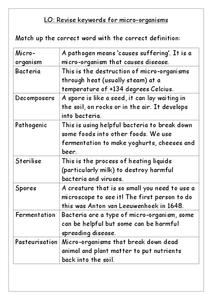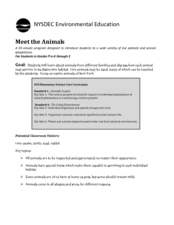Curated OER
Micro-Organisms
In this identifying the definitions of micro-organisms instructional activity, students match the correct key words with the correct definitions. Students match 8 answers.
Curated OER
Animal Classification
Third graders differentiate between vertebrates and invertebrates, and identify the main characteristics of mammals, fish, reptiles, amphibians, and birds. They sort and categorize different types of balls, discuss the characteristics...
K12 Reader
Adapting to Survive
Life science and language arts come together in a passage about animal adaptation. After kids learn about how organisms adapt to conditions in their environments, they complete five reading comprehension questions based on context clues...
McGraw Hill
Arthropods
Are spiders related to crabs? Study the order of arthropods with a reading selection about animal diversity. It provides details about each class within the order, as well as vivid pictures and explanatory charts.
Science 4 Inquiry
The Classification of Living Things
It's a classification sensation! Demystify why we classify using an inquiry activity that helps your class sort things out. Groups begin by classifying a variety of shoes before they research organisms and design their own dichotomous...
Conserve Wildlife Foundation of New Jersey
The Great Peregrine Scavenger Hunt - On the Internet
The story of one bird provides valuable insight into general animal behaviors and interactions. Young researchers investigate the peregrine falcon using a web search. They analyze the behaviors of the raptor including its migration...
NOAA
Individual Species in the Deep Sea
A tube worm's outer covering is made of chitin, the same material that makes up the shells of lobsters and crabs. Scholars create tube worms and analyze and discuss the longevity of organisms living near cold seeps. They then discuss and...
Cornell University
Plant Cell Crime Scene
Use science to solve the mystery of the Poplar murder. Pupils use forensic botany to determine if a suspect could be the killer. By analyzing images from a Transmission Electron Microscope, learners determine if the material found on the...
Global Oneness Project
The Consciousness of Nature
Scholars voice their opinions about animal consciousness with an article that challenges common ideas about nature. After reading the article, learners engage in a thoughtful discussion before writing out their arguments in a persuasive...
American Museum of Natural History
What's This? Reproduction
Attracting the right mate is as important for humans as any other species. An interesting lesson teaches individuals about several strategies that animals and plants have adapted to attract their mates. From colorful nests to powerful...
Curated OER
Animal Adaptations: Focus on Bird Beaks
Sixth graders explore bird beaks as animal adaptation. In this bird adaptation lesson, 6th graders conduct an experiment to determine the connection between the shape of a bird's beak and the food it eats.
Curated OER
Comparing Plant and Animal Cells in a Venn Diagram
In this science graphic organizer worksheet, students fill in a Venn Diagram by comparing plant and animal cells. They use the words from the word bank to fill in each portion of the graphic organizer. They use words such as...
Curated OER
Plant and Animal Cells KWL Graphic Organizer
In this science graphic organizer worksheet, students complete a KWL chart for a study of plant and animal cells. They record what they know, what they want to know, and what they learned.
Curated OER
What is an animal?
In this animal worksheet, students determine five characteristics that all animals have in common. Using these characteristics, students fill in a table demonstrating what living things have those characteristics.
Curated OER
What is an animal?
In this animal worksheet, students determine which characteristic of an animal matches the given statement. Students describe illustrations of animals using the terms radial symmetry, bilateral symmetry, and no symmetry.
Curated OER
Animal Symmetry and Phyla
In this animal kingdom worksheet, students complete a graphic organizer by writing in the phylum and body symmetry for the 12 animals listed.
Curated OER
Animal Report
Fourth graders research an animal of their choice and take the information in outline form, and write paragraphs to complete a final report form, draw a picture of their subject, and mount for display.
Curated OER
Animal Stationary
In this writing template, students can add writing and color to a piece of lined paper bordered by illustrations. The pictures include a giraffe, a cat, and two elephants.
Curated OER
Keys and Webs
Students explore and classify organisms found in a Rocky Mountain Ecosystem. Through discussions, students examine the effects upon an ecosystem if a component was removed or a new component was added. As a class, they survey reasons...
Curated OER
Rainforest Plant or Animal?
Learners explore the major functions of plants and animals. In this rainforest lesson plan students create a Venn diagram to compare and contrast animals in the rainforest.
Curated OER
Meet the Animals
The class will examine a series of live or stuffed animals in order to learn how different animals survive in distinctive habitats. As they examine each animal, they will be asked a series of critical thinking questions geared at getting...
Curated OER
Formal Writing Introduction
Give your class tips on formal writing. A paragraph format is outlined along with specifics for writing a conclusion sentence. A few transitions are listed to vary sentences and sentence structure. Pull this resource back out whenever...
Curated OER
Food Chain
Third graders role-play various organisms from a food chain to illustrate how a food chain works. In relay style, 3rd graders fill their cups (stomachs) and, in turn, fill a larger organism's cup (stomach) to visualize the importance of...
Curated OER
A Home for a Cricket
First graders build a habitat for crickets after studying animal survival needs. They care for and observe the crickets in the classroom habitat.

























